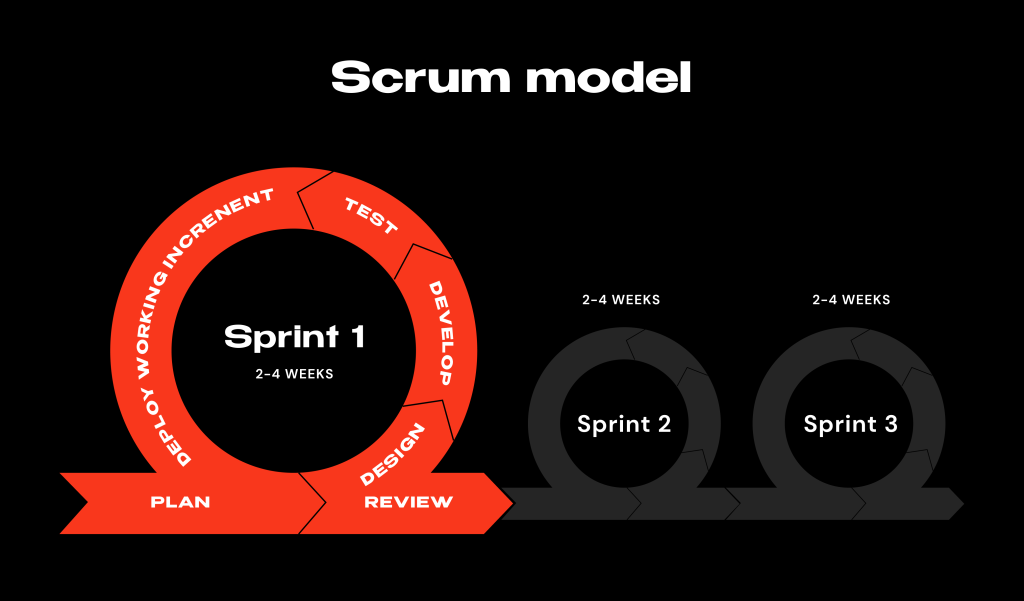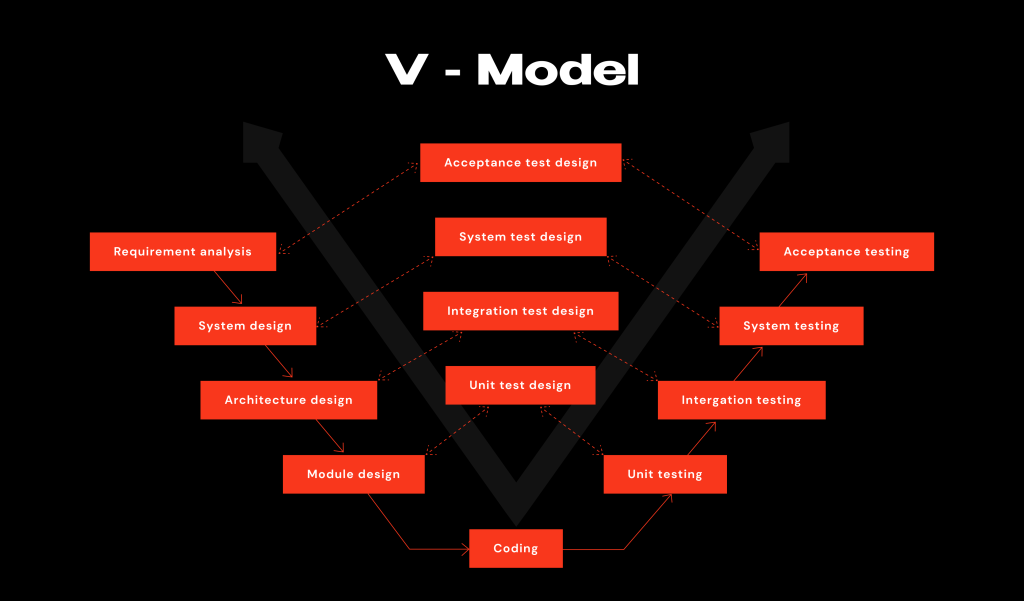Most Popular Software Development Models

Over the years, numerous software development models have emerged to make this process more effective. From traditional to modern ones, developers have a range of options to select from. In this article, we explore popular development models and their key differences, benefits, and drawbacks. Whether you’re an expert or a newcomer to the field, you won’t want to miss this comprehensive guide!
What are Software Development Models
SDMs refer to the various methodologies companies follow when creating various kinds of applications. They provide a detailed roadmap of the whole process, outlining all steps and their correct order.
Some organizations decide not to follow such a strict “action plan”. It is either due to time constraints or a belief that the process is too rigid and inflexible. While there may be some short-term benefits to skipping it, in the long run, it is a bad idea for several reasons. Firstly, not using it leads to poor code quality. Without a structured plan, tech specialists may skip important steps. It results in apps that are buggy, unreliable, and prone to crashes and errors. Secondly, you may expect budget overruns and missed deadlines. Without a set structure, specialists go back and forth between stages. It leads to delays and increased costs. Additionally, without proper risk management, unforeseen issues arise, causing delays.
How to Choose the Right Development Models
Project Requirements
What features do you want to include? Are there any possible constraints? If you have a clear understanding of what you want to achieve, choose a linear model like Waterfall. If you expect something complex and evolving, an iterative or Agile approach is more fitting.
Team Size/Experience/Interaction
Some methodologies like Agile require a high degree of collaboration among specialists. If you have a smaller team, a more traditional option like Waterfall is easier to manage.

Timeline
Some approaches have a strict sequential process that takes longer to complete. If you have a tight deadline, Agile would allow you to deploy a working version faster.
Potential risks
Consider risks associated with your case (i.e. technical challenges, functionality adjustments etc.).
Flexibility
If you expect frequent adjustments/updates, an Agile or Iterative options could be a good fit.
Feedback
Without feedback from potential users, you risk building a useless product no one wants to download and buy. Consider how to gather opinions. Ensure your choice includes mechanisms for incorporating received feedback into the workflow.
Maintenance
Does the chosen option include mechanisms for managing ongoing maintenance and updates? Ask this question before making the final decision.
Types of Software Process Models
Waterfall
This is a traditional methodology with a sequential, linear approach. It consists of distinct phases completed in a strict sequence:

It relies on upfront planning and documentation. It is the most suitable option if the requirements are clear and stable. Examples include building a basic website or a simple mobile app, or developing a standalone application with limited complexity.
It also works for products that require strict adherence to regulatory standards and documentation. Industries such as healthcare, finance, and aerospace often utilize it to ensure thorough documentation and compliance with legal or safety regulations.
Agile
The methodology is based on collaboration, flexibility, and continuous delivery. It emphasizes iterative work cycles and cross-functional teams working in short sprints. It breaks the workflow into smaller chunks. It means you return and make changes if needed.
It consists of several iterative cycles, each focusing on delivering a set of features incrementally. Unlike the previous options, it involves collaboration between developers, stakeholders, and clients.
It is well-suited for a variety of projects, particularly those that involve a high degree of complexity and uncertainty.
Scrum, Kanban
Scrum is focused on delivering products in short iterations. It is highly flexible and adaptable. It means you quickly change direction based on feedback from stakeholders. Scrum also prioritizes teamwork, with specific roles like Product Owner or Scrum Master.

Kanban is a visual system for managing work as it moves through different stages. It focuses on visualizing the workflow to improve efficiency.

V-Model
Here, you have to deal with testing at every step, so defects are identified early. Visually, it reminds a V-shape. Each downward slope represents a development phase with the upward slope being the testing one.

It is particularly well-suited for projects with clear and stable requirements. It is commonly used in the creation of safety-critical systems such as medical devices, aerospace or automotive systems.
Spiral
Each loop represents a development phase and involves identifying/mitigating risks, evaluating the progress, determining next steps.

It works for cases involving high levels of complexity or which require innovative solutions. For instance, for building products that require regular updates or new feature releases. Plus, when developing prototypes or proof of concept projects, this option can also be effective.
Incremental/Iterative
The Incremental one emphasizes breaking the whole process into smaller chunks (or increments). Each increment involves building and testing a specific set of features. Each increment is built upon the previous one until the final version is ready:


In projects involving data analytics, the approach is often employed to build and refine predictive models or analytics pipelines. Each iteration can involve the addition of new data sources, refining algorithms, and incorporating feedback from data scientists or end-users.
Rapid Application Development
This structured approach emphasizes rapid prototyping and iterative development, with each iteration building upon the previous one. It involves a collaborative approach, allowing for early feedback and rapid changes.
RAD is well-suited for developing mobile apps, especially those with relatively simple functionalities and quick time-to-market requirements.
When a project requires creating an MVP to test its viability or attract early adopters, RAD can also be highly effective. It enables quick creation and release of a basic version to gather user feedback and validate the concept.
Big Bang
This approach involves building the entire system in one go without any structured plan. The model is not typically recommended for most cases due to its inherent risks and lack of structured planning. However, there are a few specific scenarios where it may be suitable.
For instance, if you are working on a small personal project with limited scope and no strict deadlines, and there are no external dependencies or stakeholders involved.
When creating a proof-of-concept or prototype that doesn’t require high reliability or extensive testing, Big Bang can also be used. It allows for quick implementation without the need for detailed planning or extensive documentation.
Conclusion
Selecting the right methodology helps you to effectively plan and build your product. Moreover, you mitigate risks and manage timelines/costs. Plus, you make sure your solution meets quality standards. Your choice depends on several factors like timeline or flexibility. Therefore, weigh all the options and consider your needs here. It will help you select the most suitable variant and eventually maximize your ROIs!
FAQ
-
What are software development models?
- Software development models in software engineering are a set of structured approaches IT professionals utilize when creating high-quality digital products. These software engineering models provide a framework for designing, building, testing, and deploying apps in an organized way.
-
Is it possible to use two different models at the same time?
- It is possible to use two different software process models simultaneously, but it may be challenging. It involves combining elements of two or more software development process models. While such a hybrid solution may offer benefits such as increased flexibility and customization, it is more difficult to manage.
-
Which software development model is the most effective?
- There are multiple models in software engineering, but none of them is universally considered the most effective. Each of these software design models has its own strengths and weaknesses. The most suitable software model depends on your specific goals.
-
How to choose the right software development models?
-
Take into account several factors when deciding among different software development models:
- Analyze initial requirements;
- Evaluate team’s size/experience level + communication style;
- Consider the expected timeline;
- Assess risks and flexibility levels;
- Determine how you plan to gather user feedback;
- Consider how to manage app maintenance.
-
Tell about projects you have recently completed with the help of Agile methodology?
-
A few months ago, we undertook the challenge of creating a complex healthcare platform for a chain of private clinics.
We conducted regular sprint planning sessions. As we progressed through each sprint, we embraced continuous integration and delivery practices. This allowed us to regularly test and deploy new features of the future platform. We developed an integrated electronic health record (EHR) system. Clinics can securely store and access patient medical records in a centralized database. We implemented appointment scheduling functionality. It enabled patients to book appointments online and receive reminders.
We also integrated a messaging system within the platform. It allowed doctors, nurses, and patients to communicate securely. The billing and payment module facilitated accurate and timely invoicing for medical services.
To enhance patient engagement, we built a patient portal. It provided access to their medical history, test results, and personalized health information. The methodology played a crucial role in keeping tasks on track and avoiding delays. Its iterative nature allowed us to deliver incremental value to the client regularly.
We also built a complex Edutech platform for an educational center. Our team began by developing a user-friendly dashboard. It allowed students and teachers to access their respective accounts. We implemented a comprehensive student management system. It enabled administrators to easily enroll and manage students’ information. We also incorporated a robust course management module. This module allowed administrators to create and organize courses with ease. To enhance collaboration, we integrated a virtual classroom feature. It supported live video conferencing and interactive whiteboards.
Our team developed a sophisticated assessment module. It enabled teachers to create quizzes, exams, and assignments and track students’ progress. We also designed a comprehensive reporting system. It generated detailed analytics and performance reports for both students and teachers.
We regularly engaged with stakeholders to gather feedback and make necessary improvements.
We also embarked on building a supply chain management platform for a logistics company. EDE team worked closely with the client, conducting regular sprint reviews. We incorporated their feedback into subsequent iterations.
Our team implemented a robust inventory management feature. The company could track and manage their inventory in real-time with:
- convenient barcode scanning
- automatic stock updates
- alerts for low stock levels
Additionally, we integrated a comprehensive order management system. It facilitated order placement, tracking, and fulfillment. We also implemented a powerful analytics module with insightful reports and data visualizations.
To ensure smooth coordination between different stakeholders, we incorporated a vendor management feature. It allowed the company to manage their relationships with suppliers with:
- easy supplier onboarding
- performance tracking
- contract management.
Addressing the need for transparency and traceability, we incorporated a robust tracking and tracing feature. It allowed the company and their custom